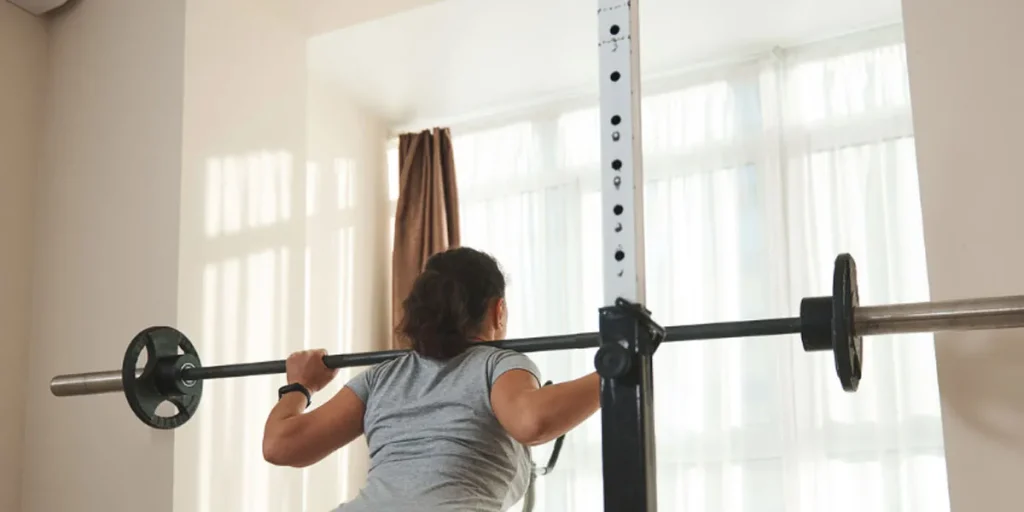An Olympic barbell typically weighs 20 kilograms (44 pounds). Standard men’s barbells are 2.2 meters (7.2 feet) long.
Embarking on a fitness journey or advancing in weightlifting, the Olympic barbell is a fundamental piece of equipment utilized globally.
A good understanding of its weight is crucial for tracking progress and maintaining proper form.
The barbell’s standardized weight ensures consistency in training and competition.
Perfect for Olympic weightlifting, powerlifting, and bodybuilding, its robust construction is designed to support substantial weights.
Precision in the design allows athletes to focus on performance, knowing the exact specifications of the equipment.
The barbell’s weight also influences the calculation of total load lifted, making it essential for setting personal records and competing on a level playing field.

Standard Weight Of Olympic Barbells
The Standard Weight of Olympic Barbells is a fundamental aspect for athletes and gym enthusiasts alike.
Understanding the precise weight specifications is crucial for those training for competitions or personal benchmarks.
These barbells are crafted to meet strict guidelines which ensure consistency in training and competition environments.
Men’s Vs Women’s Barbells
Olympic barbells come in two primary classes: Men’s and Women’s barbells. Each is designed with a specific weight, length, and diameter to suit the differing needs of male and female lifters.
| Barbell Type | Weight | Length | Diameter |
|---|---|---|---|
| Men’s Olympic Barbell | 20 kilograms (44 pounds) | 2.2 meters (7.2 feet) | 28 millimeters (1.1 inches) |
| Women’s Olympic Barbell | 15 kilograms (33 pounds) | 2.01 meters (6.6 feet) | 25 millimeters (0.98 inches) |
Men’s barbells are heavier and thicker, while women’s barbells are lighter and slimmer for comfortable grip.
Factors Influencing Barbell Weight
Multiple factors can influence the overall weight of an Olympic barbell. Knowledge of these elements can provide insight for those looking to purchase or train with these barbells.
- Material composition: High-grade steel ensures durability and affects weight.
- Bar finish: Different coatings, like chrome or zinc, can alter bar weight slightly.
- Sleeve construction: The end parts holding the weights may vary in design and material.
- Manufacturing brand variance: Slight differences in weight standards can occur between brands.
While the weight differences are minimal, high-level athletes might notice the impact on their performance.
Anatomy Of An Olympic Barbell

Understanding the anatomy of an Olympic barbell reveals why it’s essential for weightlifting. It’s more than just a metal rod.
Olympic barbells have unique features, catering to high-performance athletes. Dive into the materials, design, dimensions, and specifications.
Materials And Design
Olympic barbells are crafted for strength and durability. Manufacturers use high-grade steel to resist bending.
The steel undergoes special treatments. These treatments increase hardness and decrease maintenance needs.
- Steel Type: Typically alloy or carbon steel
- Treatment: Tempering, annealing, or case hardening
- Finish: Chrome, zinc, or cerakote for corrosion resistance
The design includes rotating sleeves. These reduce wrist strain during lifts. Knurling along the bar increases grip. Some sections are smooth, tailored for different lifts.
Dimensions And Specifications
Olympic barbells follow precise specifications. Men’s and women’s bars differ slightly, suited for various competitions.
| Feature | Men’s Bar | Women’s Bar |
|---|---|---|
| Weight | 20 kilograms (44 lbs) | 15 kilograms (33 lbs) |
| Length | 2.2 meters (7.2 feet) | 2.01 meters (6.6 feet) |
| Diameter | 28 millimeters (1.1 inches) | 25 millimeters (0.98 inches) |
The bars also include loadable sleeve lengths. This is typically 16.5 inches for men’s and 13 inches for women’s bars.
These lengths accommodate weight plates for varying lift weights. The center distance between the sleeves is consistent. This ensures balance during lifts.
Each bar must withstand specific amounts of load. This ensures safety during heavy lifts. Manufacturers test and certify them to meet these standards.
Different Types Of Olympic Barbells

Training Barbells
Competition Barbells
Specialty Barbells
Measuring And Verifying Barbell Weight
Measuring and Verifying Barbell Weight is crucial for athletes and gym owners alike. An Olympic barbell usually weighs 20 kilograms for men’s bars and 15 kilograms for women’s bars.
But not all barbells are created equal. Small differences can affect performance. That’s why knowing the exact weight of your barbell is important.
Certification Standards
International Weightlifting Federation (IWF) sets the bar high for certification. For Olympic competition, barbells must meet strict guidelines.
This ensures fairness in competition. Here are key points for certified Olympic barbells:
- Men’s barbells: Must weigh 20kg, with a tolerance of +0.1% and -0.05%.
- Women’s barbells: Must be 15kg, with the same tolerance levels.
- Barbells must have a grip diameter of 28mm for men and 25mm for women.
- Weight markings must be present to ensure identification.
Weighing Techniques
For accurate measurements, specific techniques are necessary. Properly calibrated scales are a must. Here’s how to weigh your barbell correctly:
- Place the barbell on a flat and stable surface.
- Use a digital scale that’s accurate to at least 0.01kg.
- Ensure the scale is zeroed out before placing the barbell on it.
- Balance the barbell so it does not roll off the scale during measurement.
Double-check the weight to confirm accuracy. If a barbell fails the test, it may not be up to Olympic standards.
Knowing the precise weight helps maintain the integrity of training and competition.
Impact Of Weight Variation
Understanding how heavy an Olympic barbell is matters a lot. It affects how athletes train and compete. It also ensures safety during workouts.
Let’s dive into how different weights impact performance and safety.
Athlete Performance
Olympic barbells have a standard weight, but slight variations do exist. These can affect an athlete’s lifting technique and overall performance in competition. Here are key points:
- Lifting technique: Consistent weight means reliable training.
- Muscle development: Variations can lead to uneven muscle growth.
- Competition readiness: Familiarity with the barbell’s weight is crucial.
Safety Considerations
A barbell’s weight isn’t just about power; it’s about protection too. Heavier weights than expected can lead to accidents. Understand how weight affects safety:
- Weight handling: Knowing the barbell’s mass is essential for lifters’ safety.
- Injury prevention: Accurate weight prevents strain and injury.
- Equipment integrity: Consistent barbell mass ensures long-term safety.
Caring For Your Olympic Barbell
Once you lift an Olympic barbell, the next step is caring for it. Proper maintenance ensures your barbell remains in top condition.
Below are essential tips for keeping your Olympic barbell as good as new.
Maintenance Routines
To keep your barbell in shape, implement a regular maintenance routine. Start by wiping down the bar after each use to remove sweat and moisture.
Apply a thin layer of protective oil every few months to keep the bar from rusting. Check and tighten any loose ends on the sleeves regularly.
- Wipe away sweat and chalk after each session.
- Inspect barbell for loose parts and tighten as necessary.
- Use oil lightly to prevent rust.
- Store horizontally on a rack to avoid bending.
Longevity And Performance
Your barbell’s lifespan depends on how well you maintain it. A clean, rust-free barbell guarantees smooth performance over time.
Regular maintenance directly influences longevity and function. Avoid dropping the barbell from heights, as consistent abuse shortens its life.
- Drop with care to prevent warping.
- Avoid excessive moisture to protect against rust.
- Regular checks can catch issues before they worsen.
Caring for an Olympic barbell is straightforward. Stick to these maintenance tips to ensure your barbell is always ready for your next lift.
FAQs About the Weight of an Olympic Barbell
What Is The Standard Weight Of An Olympic Barbell?
An official Olympic barbell typically weighs 20 kilograms, which is equivalent to 44 pounds. It’s designed to comply with the standards set by the International Weightlifting Federation.
How Does A Women’s Olympic Barbell Differ In Weight?
A women’s Olympic barbell is lighter and weighs 15 kilograms or about 33 pounds. It is also shorter and has a smaller diameter grip to accommodate female lifters’ typically smaller hands.
Can Olympic Barbells Hold Different Weight Capacities?
Yes, Olympic barbells can hold varying weights, but high-quality ones are built to handle loads of over 600 kilograms, or 1,300 pounds. This allows for significant weight increments in strength training.
What Materials Are Used To Make Olympic Barbells?
Olympic barbells are usually made from high-tensile strength steel. This material is chosen for its durability and ability to flex under heavy loads without bending permanently.
Conclusion
Wrapping up, the standard Olympic barbell tips the scales at roughly 20 kilograms, a vital detail for any weightlifting enthusiast.
With this knowledge, you’re well-equipped to track your lifting progress accurately. Remember, the precise weight can vary, so always check your gym’s equipment.
Happy lifting!
